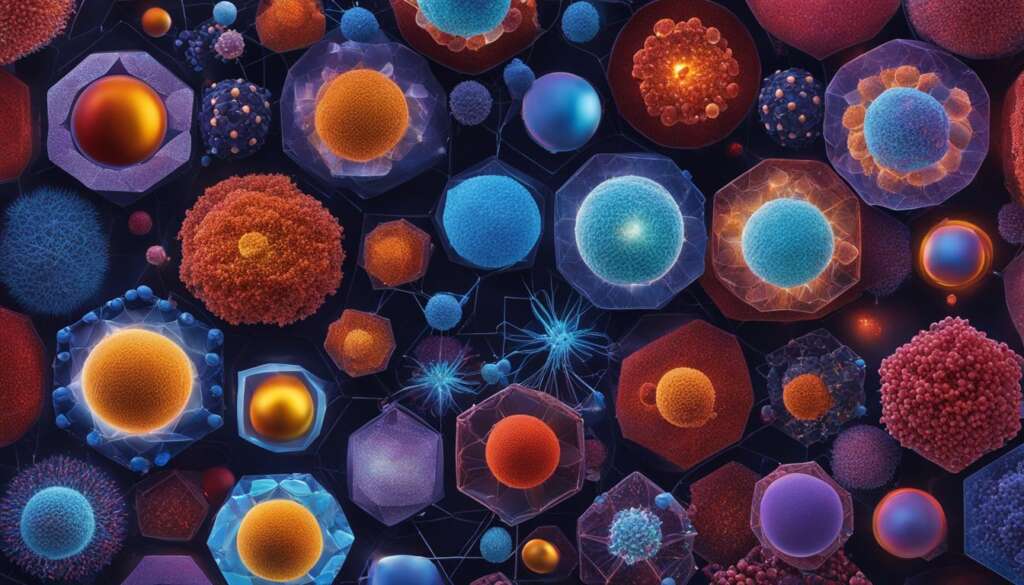Table of Contents
Nanotechnology is a rapidly growing field with promising applications across various industries. It involves manipulating and controlling matter at the nanoscale, which is the scale of individual atoms and molecules. By investing in nanotechnology, individuals and businesses can take advantage of the opportunities provided by this innovative market and capitalise on its burgeoning growth.
Key Takeaways:
- Investing in nanotechnology offers opportunities for growth and innovation.
- Nanotechnology involves manipulating matter at the nanoscale.
- The nanotechnology market is rapidly expanding across industries.
- Key players in the nanotechnology industry are driving advancements.
- Governments are investing in nanotechnology research and development programs.
What is Nanotechnology and What Makes it Different?
Nanotechnology refers to the study of manipulating and controlling matter at the nanoscale, which is generally referred to as the scale of individual atoms and molecules. Scientists and engineers can manipulate materials and structures on a very small scale, often at the molecular and atomic level, using nanotechnology. This technology has the potential to revolutionize various industries by producing new materials and devices with unique properties and capabilities.
At the nanoscale, the behavior of materials and structures can exhibit completely different properties compared to their macroscale counterparts. This is due to quantum effects and surface area-to-volume ratio considerations, leading to enhanced mechanical, chemical, and optical properties. By harnessing these unique properties, nanotechnology enables the development of innovative solutions for a wide range of applications.
The ability to manipulate matter on a nanoscale opens up new possibilities for designing materials with tailored properties and functionalities. For example, nanoparticles can be engineered to have specific shapes, sizes, and surface characteristics to achieve desired effects. This level of precision allows for the creation of advanced materials with improved strength, flexibility, conductivity, and more.
Moreover, nanotechnology plays a crucial role in developing nanosensors, which are capable of detecting and responding to changes in the environment at the molecular level. These sensors have applications in industries such as healthcare, environmental monitoring, and food safety, where accurate and sensitive detection is essential.
“Nanotechnology is not just making things smaller, but rather the ability to carefully control and manipulate materials and structures at the nanoscale, leading to novel properties and functionalities.”
The applications of nanotechnology are vast and diverse. From electronics and energy to medicine and environmental remediation, nanotechnology offers endless possibilities for innovation. In the next section, we will explore the market prospects and opportunities in the field of nanotechnology.
Market Prospects and Opportunities
The nanotechnology market has tremendous prospects and opportunities for growth. It is being applied in various sectors, including medicine, electronics, energy, textiles, and more. In the healthcare industry, nanotechnology is being used in drug delivery, diagnostics, and therapeutics. In electronics, it enables miniaturization and higher efficiency of devices. The market also offers opportunities in renewable energy solutions and the development of specialized nanomaterials.
“The nanotechnology market is projected to reach $XX billion by 2027, growing at a CAGR of XX% during the forecast period.” – Market Research Report
Nanotechnology’s applications in medicine are revolutionizing the healthcare industry. Nanoparticles can be designed to deliver drugs directly to the targeted cells in the body, increasing treatment efficacy while minimizing side effects. Additionally, nanotechnology is transforming diagnostics and imaging techniques, enabling earlier detection of diseases and more precise monitoring of treatment effectiveness.
In the electronics industry, nanotechnology plays a vital role in advancing device capabilities. By manipulating materials at the nanoscale, electronic components can be made smaller, faster, and more energy-efficient. This technology drives innovations in areas such as microprocessors, sensors, and displays, contributing to the continuous evolution of consumer electronics and industrial applications.
Moreover, nanotechnology offers significant opportunities in the energy sector. It enables the development of advanced nanomaterials for energy storage, such as high-capacity batteries and ultracapacitors. Nanotechnology also enhances the efficiency of solar cells, paving the way for more sustainable and cost-effective renewable energy solutions.

| Industry | Applications of Nanotechnology |
|---|---|
| Medicine | Drug delivery systems, diagnostics, tissue engineering |
| Electronics | Miniaturization, improved energy efficiency, advanced materials |
| Energy | Energy storage, solar cells, sustainable solutions |
| Textiles | Advanced fabrics, water and stain resistance, antimicrobial properties |
Nanotechnology also presents opportunities in the textiles industry. Innovative nanomaterials can enhance the properties of fabrics, making them water and stain-resistant, durable, and even antimicrobial. This opens up possibilities for developing specialized textiles used in sports, healthcare, and protective clothing sectors.
With its wide-ranging applications, the nanotechnology market is poised for significant growth in the coming years. Investments in research and development, as well as collaborations between academia and industry, are driving advancements and fostering the commercialization of nanotechnology-based products and solutions.
By capitalizing on the potential growth of the nanotechnology market, businesses and investors can position themselves at the forefront of innovation and tap into the lucrative opportunities presented by this rapidly evolving industry.
Players in the Nanotechnology Industry
Several key players are driving the advancements and growth in the nanotechnology industry. These companies are at the forefront of research, development, and commercialization of nanotechnology applications.
Industry Leaders
Some of the industry leaders in nanotechnology include:
- Nanometrics Incorporated
- FEI Company
- Nanosys, Inc.
- Bruker Corporation
Emerging Players
In addition to the industry leaders, there are emerging nanotechnology companies making significant contributions to the field, such as:
- Nanoco Group plc
- Nanophase Technologies Corporation
- Nanogate SE
These nanotechnology companies are pushing the boundaries of innovation and revolutionizing various industries. Their cutting-edge solutions and technologies are shaping the future of nanotechnology.
Leading nanotechnology companies such as Nanometrics Incorporated and Bruker Corporation are paving the way for groundbreaking advancements in the industry.
| Company | Description |
|---|---|
| Nanometrics Incorporated | A leading provider of advanced metrology and process control solutions for nanotechnology applications. |
| FEI Company | A global leader in imaging and microscopy solutions, enabling nanoscale analysis and research. |
| Nanosys, Inc. | An innovative company specializing in the development and commercialization of nanomaterials and nanotechnology-enabled solutions. |
| Bruker Corporation | A prominent player in nanotechnology research and development, offering advanced scientific instruments and solutions. |
| Nanoco Group plc | A nanotechnology company focused on the development and production of quantum dots for display, lighting, and other applications. |
| Nanophase Technologies Corporation | A leading provider of engineered nanomaterials for various industries, including electronics, energy, and healthcare. |
| Nanogate SE | A technology company offering nanotechnology-based solutions for surfaces, components, and systems. |
Nanotechnology Programs of Governments
Governments around the world are recognizing the immense potential of nanotechnology and taking proactive steps to invest in research and development programs. These government initiatives are aimed at supporting scientific breakthroughs, fostering innovation, and promoting the commercialization of nanotechnology applications.
“Investing in nanotechnology research is crucial for our country’s future growth and competitiveness. Through these initiatives, we aim to create a robust ecosystem that enables scientists, researchers, and entrepreneurs to explore the vast possibilities of nanotechnology and drive economic prosperity.”
– Minister of Science and Technology
One prominent example of government support for nanotechnology is the National Nanotechnology Initiative (NNI) in the United States. Established in 2000, the NNI is a collaborative effort involving multiple federal agencies. It provides significant funding and resources to accelerate nanotechnology research across various sectors.

In addition to the United States, governments in Europe and Asia have also launched their own nanotechnology programs. These initiatives offer funding, infrastructure, and support to researchers and entrepreneurs in the nanotechnology field, ensuring continued growth and innovation.
Government Initiatives in Europe:
1. European Union Framework Programme for Research and Innovation (Horizon Europe) – This program prioritizes nanotechnology research and development to address pressing societal challenges and promote sustainable economic growth.
2. German Federal Ministry of Education and Research (BMBF) – BMBF funds various nanotechnology projects and initiatives, focusing on areas such as healthcare, energy, and environmental sustainability.
Government Initiatives in Asia:
1. National Key Research and Development Program in China – The Chinese government has allocated substantial funding towards nanotechnology research, with a focus on emerging fields such as nanomedicine and nanoelectronics.
2. Strategic Initiative for Industrial Technology Innovation (SITI) in Japan – SITI supports the development and commercialization of nanotechnology applications in industries such as electronics, automotive, and renewable energy.
| Country | Government Initiative |
|---|---|
| United States | National Nanotechnology Initiative (NNI) |
| Europe | European Union Framework Programme for Research and Innovation (Horizon Europe) |
| Europe | German Federal Ministry of Education and Research (BMBF) |
| Asia | National Key Research and Development Program in China |
| Asia | Strategic Initiative for Industrial Technology Innovation (SITI) in Japan |
Risks and Challenges of Nanotechnology
Nanotechnology holds tremendous potential for various industries, but it is not without its risks and challenges. It is important to be aware of these factors when considering investments in nanotechnology.
Health and Safety Concerns
One of the major concerns in nanotechnology is the potential health and safety risks associated with nanoparticles. When these particles are released into the environment, they may pose a threat to human health and the ecosystem. Studies have shown that certain nanoparticles can penetrate deep into the lungs and even cross the blood-brain barrier.
It is crucial to thoroughly assess the potential risks and implement appropriate safety measures to protect workers, consumers, and the environment.
Environmental Effects
Nanoparticles can also have adverse effects on the environment. When released into water bodies or soil, they may accumulate and impact aquatic organisms and ecosystems. Furthermore, nanoparticles can interact with other pollutants, potentially amplifying their toxicity.
Efforts are underway to understand and mitigate the environmental risks associated with nanotechnology through research, regulations, and best practices.
Explosion Hazards
Another important consideration is the potential for explosion hazards in nanotechnology-related processes. Certain nanomaterials and powders are highly reactive and can be prone to combustion under specific conditions.
“Proper training, handling, and storage protocols are necessary to minimize the risks of accidents and explosions in nanotechnology facilities.” – Dr. Mark Phillips, nanotechnology safety expert.
Ethical Considerations
As nanotechnology continues to advance, ethical concerns have emerged. These include issues related to privacy, surveillance, and the responsible use of nanomaterials.
It is essential to engage in ethical discussions and ensure that nanotechnology is developed and deployed in a responsible and accountable manner.
Regulatory Considerations
To address the risks and challenges associated with nanotechnology, regulatory bodies and stakeholders are actively working to establish guidelines and standards. Regulatory frameworks ensure that nanotechnology products and applications meet safety, health, and environmental requirements.
Companies and insurers also play a crucial role in managing the risks associated with nanotechnology. They evaluate and address potential risks through risk assessments, insurance coverage, and risk management strategies.
When investing in nanotechnology, regulatory compliance should be a top priority to mitigate potential risks and ensure a sustainable and responsible approach.
This section highlights the risks and challenges posed by nanotechnology. Health and safety concerns, environmental effects, explosion hazards, ethical considerations, and regulatory requirements must be carefully considered. By acknowledging these factors, stakeholders can plan and implement nanotechnology strategies that prioritize safety, sustainability, and social responsibility.
Nanotechnology Applications in Different Industries
Nanotechnology is revolutionizing multiple industries, offering innovative solutions and advancements in various sectors. Here are some key applications of nanotechnology in different industry sectors:
1. Medicine: Nanotechnology is transforming the medical field by enabling targeted drug delivery systems, diagnostics, and tissue engineering. It provides precise control over drug release, enhancing treatment effectiveness and minimizing side effects. Nanoparticles can also be used for imaging techniques and regenerative medicine.
2. Electronics: Nanotechnology plays a crucial role in the electronics industry, enabling the development of smaller, faster, and more efficient devices. Nanoscale components and materials offer advancements in semiconductors, display technologies, and energy storage devices.
3. Energy: The energy sector benefits from nanotechnology with improved energy storage solutions and more efficient solar cells. Nanomaterials enable enhanced capacity and performance, paving the way for cleaner and sustainable energy sources.
4. Textiles: Nanotechnology enhances textile properties with functionalities such as stain resistance, moisture management, and UV protection. Nanocoatings can make fabrics waterproof or antimicrobial, improving durability and performance.
5. Automotive: Nanotechnology finds applications in the automotive industry for lightweight and high-strength materials, improving fuel efficiency and reducing carbon emissions. Nanocoatings also protect car surfaces from scratches and corrosion, extending their lifespan.
Nanotechnology Applications in Medicine
The medical sector is one of the primary beneficiaries of nanotechnology. It has revolutionized various areas, including:
- Drug delivery systems
- Diagnostics
- Tissue engineering
“Nanotechnology provides precise control over drug release, enhancing treatment effectiveness and minimizing side effects.”
Nanotechnology Applications in Electronics
Nanotechnology drives advancements in electronics, enabling the development of:
- Smaller devices
- Faster devices
- More efficient devices
“Nanotechnology plays a crucial role in the electronics industry, offering advancements in semiconductors, display technologies, and energy storage devices.”
Nanotechnology Applications in Energy
The energy sector benefits from nanotechnology through:
- Improved energy storage solutions
- More efficient solar cells
“Nanomaterials enable enhanced capacity and performance, paving the way for cleaner and sustainable energy sources.”
Nanotechnology Applications in Textiles
Nanotechnology enhances textile properties by providing functionalities such as:
- Stain resistance
- Moisture management
- UV protection
“Nanocoatings make fabrics waterproof or antimicrobial, improving durability and performance.”
Nanotechnology Applications in Automotive
In the automotive industry, nanotechnology is used for:
- Lightweight and high-strength materials
- Fuel efficiency improvements
- Carbon emission reductions
“Nanocoatings protect car surfaces from scratches and corrosion, extending their lifespan.”
Nanotechnology continues to push the boundaries of possibilities in various industries, driving advancements, and offering new opportunities for growth and innovation.
| Industry | Key Applications |
|---|---|
| Medicine | Drug delivery systems, diagnostics, tissue engineering |
| Electronics | Smaller, faster, and more efficient devices |
| Energy | Improved energy storage, solar cells |
| Textiles | Functional coatings, stain resistance, UV protection |
| Automotive | Lightweight materials, fuel efficiency, corrosion protection |
Nanotechnology in Food and Agriculture
Nanotechnology has the potential to revolutionize the food and agriculture industry, offering numerous applications that can enhance food safety, crop protection, and nutrient delivery. By harnessing the power of nanotechnology, innovative solutions can be developed to address key challenges in these sectors.
Improving Food Safety
Nanotechnology plays a crucial role in ensuring food safety by enabling the development of nanosensors capable of detecting pathogens and contaminants. These nanosensors can be integrated into food packaging materials or used directly in food processing to provide real-time monitoring and early detection of harmful agents. This proactive approach enhances food safety standards and helps prevent the spread of foodborne illnesses.
Enhancing Crop Protection
In agriculture, nanotechnology offers novel strategies for crop protection. Nanoparticles can be engineered to act as smart delivery systems for pesticides, herbicides, and fertilizers. By encapsulating these agricultural agents at the nanoscale, their efficiency and targeted delivery to plants can be significantly improved. This targeted approach reduces the amount of chemicals required, minimizing environmental impact while maximizing crop yields.
Facilitating Nutrient Delivery
Nanotechnology also presents opportunities for precise nutrient delivery in agriculture. Nanostructured materials can be used as carriers for controlled-release fertilizers and micronutrients, ensuring that plants receive the right amount of nutrients at the right time. This tailored approach optimizes nutrient utilization and minimizes nutrient wastage, contributing to sustainable and efficient farming practices.
Although nanotechnology offers promising solutions for the food and agriculture industry, it is crucial to address ethical, safety, and regulatory considerations. Stakeholders must work together to ensure the responsible implementation of nanotechnology, prioritizing the safety of consumers, workers, and the environment.

Nanotechnology has the potential to revolutionize the food and agriculture industry, offering numerous applications that can enhance food safety, crop protection, and nutrient delivery. By harnessing the power of nanotechnology, innovative solutions can be developed to address key challenges in these sectors.
Nanotechnology in Healthcare and Medicine
Advancements in nanotechnology have brought significant breakthroughs in the field of healthcare and medicine. This innovative technology offers countless possibilities for improving patient outcomes and revolutionizing medical treatments.
One of the key applications of nanotechnology in healthcare is targeted drug delivery. Nanoparticles can be engineered to carry drugs directly to the affected area, minimizing side effects and maximizing the drug’s therapeutic effect. By encapsulating medications in nanocarriers, such as liposomes or polymer nanoparticles, doctors can achieve precise delivery to specific cells or tissues.
Nanoparticles also play a crucial role in imaging techniques and diagnostics. These tiny particles can be modified to enhance the contrast in medical imaging, allowing for more accurate and detailed visualization of tissues and organs. This enables healthcare professionals to detect diseases at an early stage and monitor the effectiveness of treatments.
Furthermore, nanotechnology shows immense potential in regenerative medicine. Nanomaterials can be used to create scaffolds or matrices that mimic the natural environment of cells, promoting tissue regeneration and healing. This approach holds promise for repairing damaged organs and restoring their functionality.
“Nanotechnology opens up new possibilities in drug delivery, diagnostics, and regenerative medicine, transforming the way we approach healthcare.”
The use of nanotechnology in healthcare has the potential to revolutionize medical treatments and improve patient care. It enables personalized medicine, where treatments can be tailored to an individual’s unique characteristics and needs. By precisely targeting diseased cells or tissues, nanotechnology offers the potential for more effective therapies and reduced side effects.
| Nanotechnology in Healthcare | Benefits |
|---|---|
| Targeted drug delivery | – Minimizes side effects |
| Imaging and diagnostics | – Improved visualization |
| Regenerative medicine | – Tissue regeneration and healing |
Nanotechnology in healthcare holds enormous potential for transforming the way we diagnose and treat diseases. With continued research and development, nanotechnology is poised to shape the future of medicine, leading to innovative therapies, improved patient outcomes, and enhanced quality of life.
Nanotechnology in Environmental Remediation
Nanotechnology offers innovative solutions for environmental remediation and pollution control. By harnessing the power of nanomaterials, contaminants can be effectively removed from air, water, and soil, leading to a cleaner and healthier planet. With its advanced tools and methods, nanotechnology plays a vital role in tackling environmental challenges and contributing to a more sustainable future.
Nanomaterials have the ability to target and capture pollutants at the molecular level, making them highly effective in remediation applications. They can be tailored to specifically target different types of contaminants, ensuring efficient and precise removal. Whether it is heavy metals, organic pollutants, or even microplastics, nanotechnology offers a versatile approach to pollution control.
In water treatment, nanomaterials such as nanoparticles and nanofilters can be employed to remove harmful substances. These nanoscale materials have a large surface area compared to their volume, allowing for enhanced adsorption and filtration capabilities. They can effectively remove contaminants like bacteria, chemicals, and pollutants, resulting in cleaner and safer water sources.
Similarly, nanotechnology plays a crucial role in air purification. Nanomaterials, such as nanostructured catalysts and filters, are highly efficient in capturing and neutralizing harmful airborne particles and pollutants. These materials can help reduce air pollution, improve air quality, and mitigate the negative health impacts associated with polluted air.
Soil remediation is another area where nanotechnology shows great promise. Nanomaterials can be used to break down and degrade contaminants present in the soil, making the remediation process more effective and efficient. They can also enhance the bioavailability of nutrients for plants, leading to improved soil fertility and agricultural productivity.
One exciting application of nanotechnology in environmental remediation is in the field of wastewater treatment. Nanomaterials, such as nanobubbles and nanofiltration membranes, can significantly improve the efficiency of wastewater treatment processes. They can remove pollutants and pathogens from wastewater, ensuring that it meets the required standards before being released back into the environment.
Overall, nanotechnology offers a range of powerful tools and techniques for environmental remediation and pollution control. By harnessing the unique properties of nanomaterials, we can effectively address environmental challenges and work towards a cleaner, healthier planet.
Nanotechnology in Environmental Remediation – Benefits and Applications
| Benefits | Applications |
|---|---|
| Efficient removal of contaminants | Water treatment |
| Precise targeting of pollutants | Air purification |
| Enhanced soil remediation | Soil remediation |
| Improved wastewater treatment | Wastewater treatment |
Nanotechnology Perspectives and Future Developments
The future of nanotechnology holds immense potential for further advancements and innovations. As this field continues to evolve, emerging trends point towards the convergence of nanotechnology with other disciplines, such as artificial intelligence and brain-machine interfaces. These intersections pave the way for exciting possibilities and groundbreaking applications.
Technological advancements will remain a driving force behind the progress of nanotechnology. Scientists and researchers are constantly pushing boundaries and exploring new frontiers in nanoscale manipulation. These advancements enable the development of novel nanomaterials, devices, and systems with enhanced properties and functionalities.
To stay at the forefront of this field, it is essential to keep abreast of the latest developments and emerging trends. By understanding the future trajectory of nanotechnology, investors and stakeholders can make informed decisions and capitalize on the opportunities that arise.
The Convergence of Nanotechnology with Other Disciplines
The convergence of nanotechnology with disciplines such as artificial intelligence (AI) and brain-machine interfaces (BMI) opens up exciting possibilities for interdisciplinary collaboration and innovation.
The combination of nanotechnology and AI can lead to the development of intelligent nanomaterials and nanodevices that can autonomously sense and respond to their environment. This integration has the potential to revolutionize fields such as healthcare, electronics, and environmental monitoring.
Similarly, the integration of nanotechnology with BMI offers potential breakthroughs in neuroengineering and neural interfaces. Nanoscale devices can be used to interface with the brain, enabling enhanced communication and interaction between humans and machines. This opens up possibilities for restoring sensory functions, treating neurological disorders, and augmenting human capabilities.
Technological Advancements Driving Progress
Technological advancements continue to propel the field of nanotechnology forward, enabling new possibilities and applications. These advancements include:
- Development of more precise and efficient nanofabrication techniques.
- Advances in imaging and characterization tools for nanoscale analysis.
- Understanding and control of nanoscale phenomena, such as quantum effects and surface interactions.
- Integration of nanomaterials and nanodevices with existing technologies for enhanced functionalities.
With each breakthrough, the potential for innovation and impact in various industries expands. Nanotechnology is poised to revolutionize fields such as healthcare, energy, electronics, and environmental remediation, among others.
Staying Updated with Latest Developments
Keeping up with the latest developments in nanotechnology is crucial for making informed investment decisions and identifying emerging opportunities. This can be achieved through:
- Engaging with academic and research institutions that focus on nanotechnology.
- Attending conferences, seminars, and workshops dedicated to nanotechnology advancements.
- Networking with experts and professionals in the nanotechnology field.
- Reading scientific journals and publications that cover nanotechnology research.
By staying informed, investors can anticipate future developments and make strategic investments in nanotechnology companies and projects that align with their objectives.
Key Emerging Trends in Nanotechnology and their Potential Applications
| Emerging Trend | Potential Applications |
|---|---|
| Convergence with AI | Intelligent nanomaterials, nanosensors, precision medicine |
| Integration with BMI | Neuroengineering, neural interfaces, brain-computer interfaces |
| Advanced Nanofabrication Techniques | Ultra-precise manufacturing, nano-electronics, optoelectronics |
| Quantum Nanotechnology | Quantum computing, quantum sensors, secure communications |
| Nanomedicine | Targeted drug delivery, diagnostics, regenerative medicine |
Conclusion
In conclusion, investing in nanotechnology offers significant opportunities for growth and innovation. The field has a wide range of applications across various industries, including healthcare, electronics, energy, and more. By capitalizing on the burgeoning growth of nanotechnology, investors can pave the way for future success.
However, it is essential to be aware of the risks and challenges associated with nanotechnology. Ethical considerations, safety concerns, and regulatory factors must be taken into account when making investment decisions in this field. Keeping up with the latest developments and staying informed will enable investors to make smart moves in nanotechnology investment.
The future prospects of nanotechnology are promising. As technological advancements continue to drive progress in this field, new possibilities and applications will emerge. By aligning their investments with the future trends and innovations, individuals and businesses can position themselves for long-term growth and success in nanotechnology.
FAQ
What is nanotechnology?
Nanotechnology refers to the study of manipulating and controlling matter at the nanoscale, which is generally referred to as the scale of individual atoms and molecules. Scientists and engineers can manipulate materials and structures on a very small scale, often at the molecular and atomic level using nanotechnology. This technology has the potential to revolutionize various industries by producing new materials and devices with unique properties and capabilities.
What are the prospects and opportunities in the nanotechnology market?
The nanotechnology market offers tremendous prospects and opportunities for growth. It is being applied in various sectors, including medicine, electronics, energy, textiles, and more. In the healthcare industry, nanotechnology is being used in drug delivery, diagnostics, and therapeutics. In electronics, it enables miniaturization and higher efficiency of devices. The market also offers opportunities in renewable energy solutions and the development of specialized nanomaterials.
Which companies are leading the way in the nanotechnology industry?
Some of the key players in the nanotechnology industry include Nanometrics Incorporated, FEI Company, Nanosys, Inc., Bruker Corporation, Nanoco Group plc, Nanophase Technologies Corporation, and Nanogate SE. These companies are at the forefront of research, development, and commercialization of nanotechnology applications.
Are governments investing in nanotechnology?
Yes, governments around the world are recognizing the potential of nanotechnology and investing in research and development programs. These programs aim to support scientific breakthroughs, foster innovation, and promote the commercialization of nanotechnology applications. Examples of government initiatives include the National Nanotechnology Initiative in the United States and various programs in Europe and Asia. These programs provide funding, infrastructure, and support to researchers and entrepreneurs in the nanotechnology field.
What are the risks and challenges associated with nanotechnology?
While nanotechnology offers great potential, it also presents risks and challenges. There are concerns related to the environmental and health effects of nanoparticles, as well as potential explosion hazards and ethical considerations. Regulatory bodies and stakeholders are addressing these concerns through dialogues and establishing standards. Companies and insurers also play a role in managing risks associated with nanotechnology. It is crucial to consider these factors when investing in nanotechnology.
In which industries is nanotechnology applied?
Nanotechnology finds applications in various industries. In the medical sector, it is used in drug delivery systems, diagnostics, and tissue engineering. In electronics, nanotechnology enables the development of smaller, faster, and more efficient devices. The energy sector benefits from nanotechnology through improved energy storage and solar cells. Other industries, such as textiles and automotive, also leverage nanotechnology for enhanced functionalities and performances.
How is nanotechnology applied in the food and agriculture industry?
Nanotechnology has potential applications in the food and agriculture industry. It can improve food safety by developing nanosensors for detecting pathogens and contaminants. Nanotechnology also offers solutions for crop protection and nutrient delivery in agriculture. However, it is essential to address ethical, safety, and regulatory considerations when implementing nanotechnology in the food and agriculture sector.
What are the applications of nanotechnology in healthcare and medicine?
Nanotechnology has transformative applications in healthcare and medicine. It enables targeted drug delivery systems, allowing for more precise and effective treatments. Nanoparticles can also be used in imaging techniques, diagnostics, and regenerative medicine. The use of nanotechnology in these areas has the potential to revolutionize the healthcare industry, leading to better patient outcomes and personalized medicine.
How does nanotechnology contribute to environmental remediation?
Nanotechnology offers solutions for environmental remediation and pollution control. Nanomaterials can be used to remove contaminants from air, water, and soil. They can also be employed in wastewater treatment, air purification, and soil remediation processes. Nanotechnology provides advanced tools and methods for tackling environmental challenges, contributing to a more sustainable future.
What are the future perspectives of nanotechnology?
The future of nanotechnology holds immense potential for further advancements and innovations. Emerging trends include the convergence of nanotechnology with other disciplines such as artificial intelligence and brain-machine interfaces. Technological advancements will continue to drive progress in nanotechnology, opening up new possibilities and applications. It is essential to stay updated with the latest developments in this field to make informed investment decisions.













